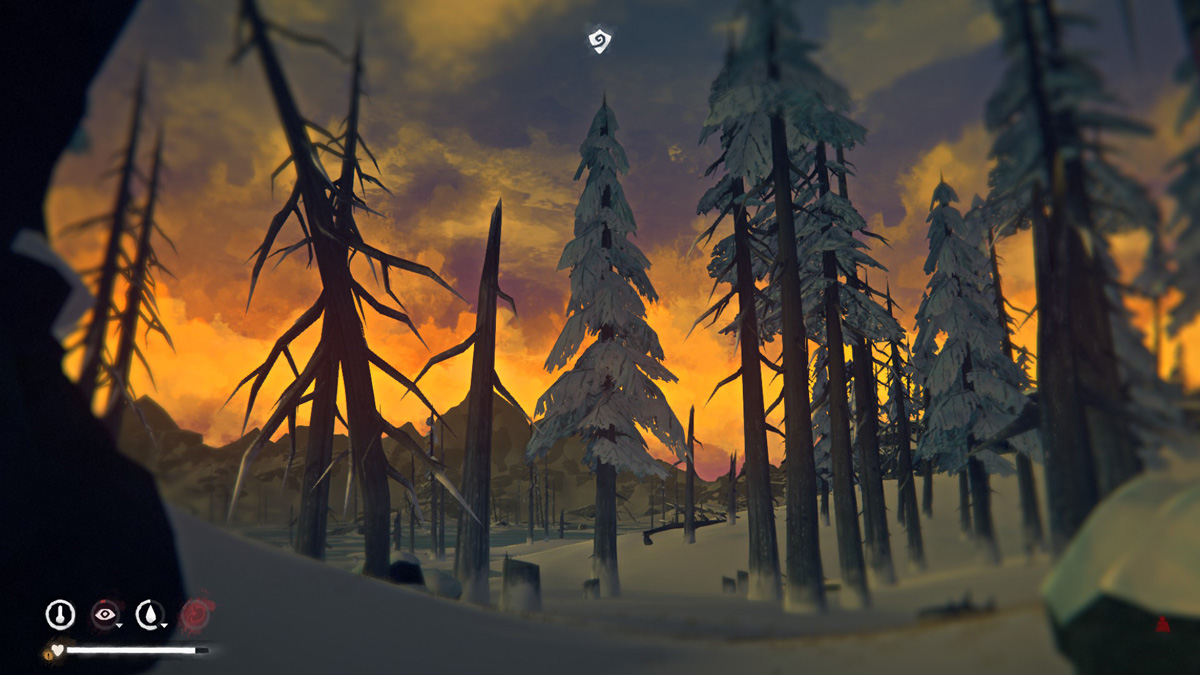
The Long Dark: Survival Tips
"So... cold..."
Keep dying in The Long Dark? Don't feel bad. I did. Especially after I decided Interloper mode was the perfect challenge for me. I love this game. It is meditative, brutal, beautiful, and addicting. There is only one goal in survival mode. How long can you stay alive? Until your last match? Until a wolf inevitably ambushes you? Or maybe you stumbled on a sleeping bear? It's likely you'll die of exposure to the elements or lack of food or water.
One thing to always remember in The Long Dark is each tiny decision can be critical to life or death. Should you repair a jacket you found to increase your warmth bonus? Or is that time better spent foraging for food? The more you play The Long Dark the better you'll get at identifying the game's subtle and brilliant mechanics, helping you make those tricky decisions.
The Long Dark actually gets easier the longer you survive. While most games get more difficult, or adapt in difficulty, The Long Dark is the opposite. With each thing you find, craft, or repair, and with every skill you level up, the game gets a tiny bit easier and your chances of surviving each day get a tiny bit better.
All the little details combine to make an amazing survival experience. What other game uses wind direction, weight carried, fatigue, terrain, and attire to calculate movement speed? Or slowly reduces the condition of almost every item in the game, forcing you to constantly replace or repair every piece of your clothing and every single tool you use?
Here is a list of essential survival tips to help you navigate The Long Dark. These tips are mainly targeted for the game's highest difficultly level, Interloper, but should also be useful on easier settings. Enjoy and happy hunting.
- Hydration
- Navigation
- Time Management
- Food
- Firewood
- Fire Starting
- Finding Gear & Resources
- Hunting
- Cooking
- Starvation Techniques vs. The Well Fed Bonus
- Clothing
- Rest
- Dealing With Wolves
- Avoiding Cabin Fever
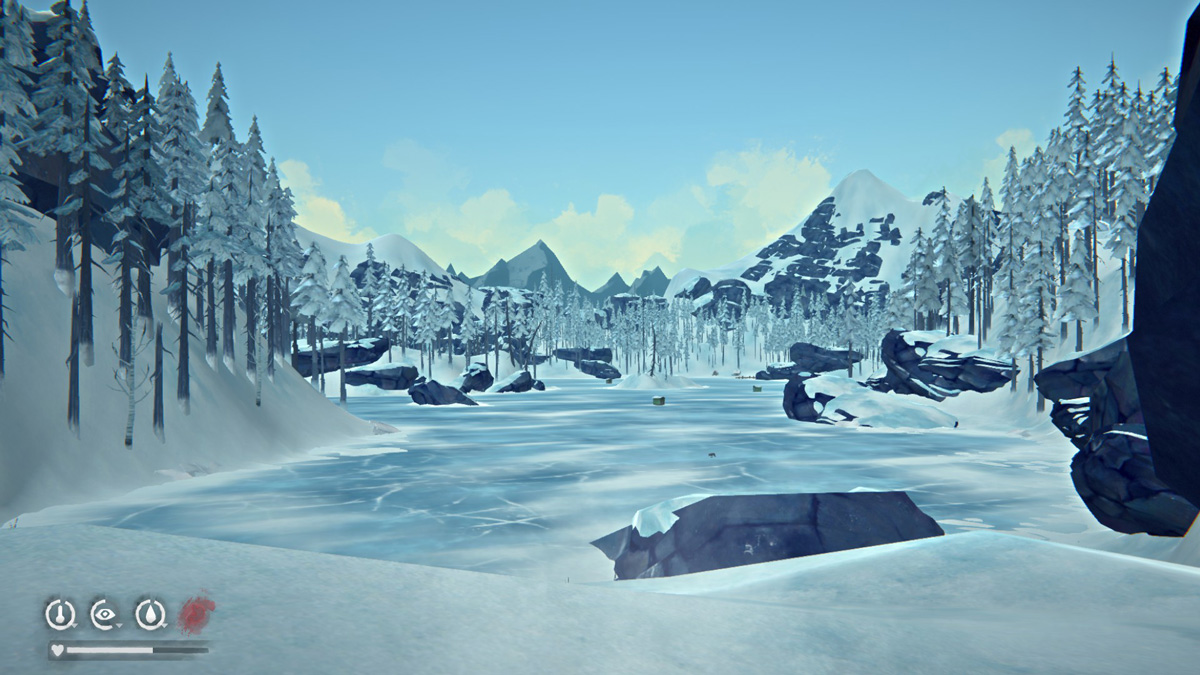
Hydration
Stay hydrated. Water consumed is weight that isn't slowing you down. Hydration is the easiest stat to keep full and will quickly lower your condition if left empty.
Your number one priority is fire so you can melt snow then boil water to sterilize it. Without doing this you'll die of dehydration quickly. Avoid drinking unsafe water. If you find Aqua Pur tables use them up first chance you get. Aqua Pur speeds up water purification thus increasing the time you can spend doing more important tasks than boiling water. Using Aqua Pur immediately also helps maximize your inventory space.
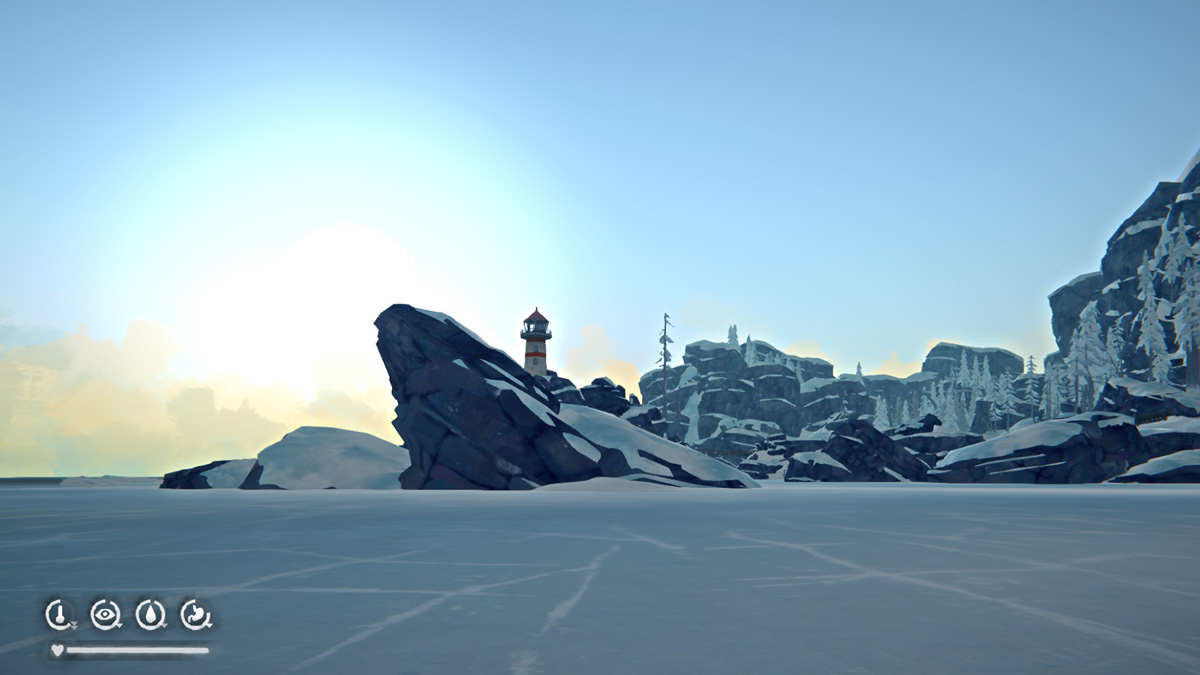
Navigation
Knowing your way around the maps is pretty much a requirement for surviving on Interloper. I'd say this is the second most important thing after securing drinkable water. When you know the maps you know where you can find food, where to find warmth, and how to travel between zones.
When exploring, follow the edges of a zone while looking for caves and structures. When the weather is clear note landmarks in the distance and use them to move in a deliberate direction. The terrain can make it easy to get turned around—causing you to wander in circles—especially during bad weather.
Try to maximize wind cover by moving alongside rock walls, hills, and buildings. The small shield icon that appears in the top center of the screen indicates you are sheltered from the wind. This helps slow down the loss of temperature and prevents you taking movement penalties from walking against the wind.
Once you have your bearings, knowing when to travel is the next thing to get the hang of. Avoid traveling in the fog. It is extremely easy to get disoriented and you can't spot wolves in the distance.
The temperature is the coldest early in the morning so I try to avoid traveling until at least late morning. Stay inside a house or cave where it is warm while checking the weather conditions every few hours. Evenings and nighttime often have fairly clear weather so these can be great times to travel, especially if you know your destination and about how long it will take you to get there.
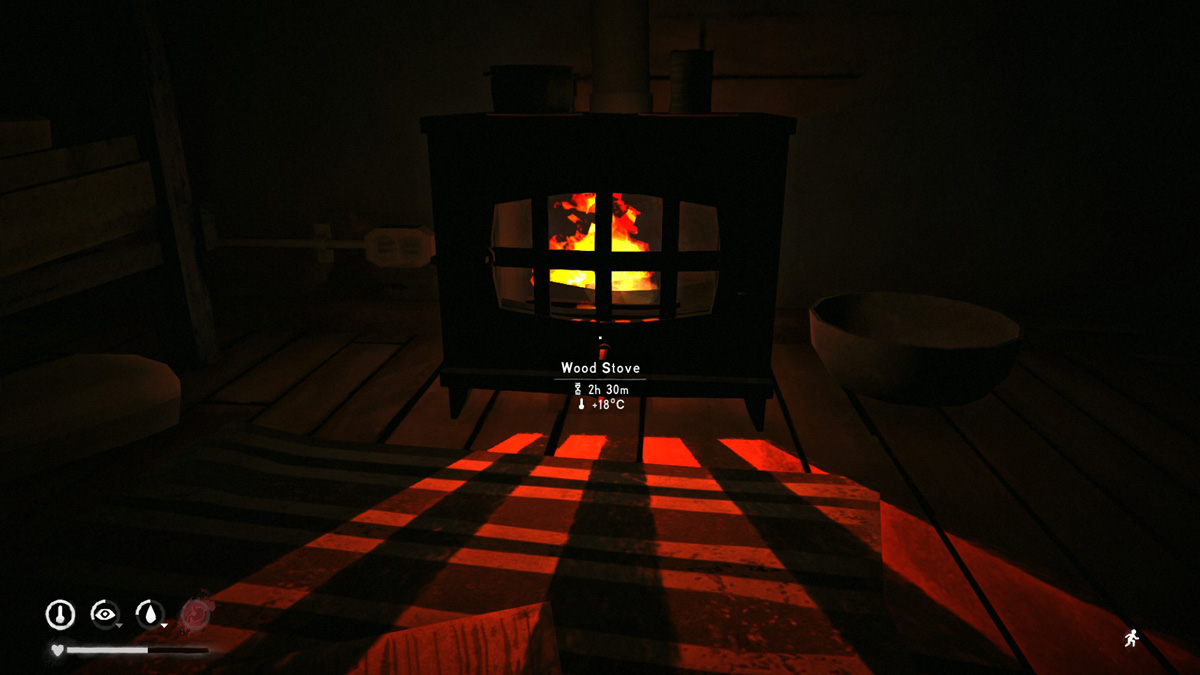
Time Management
If you could boil this game down to once strategic concept it would be time management. This is the most important and most difficult aspect of The Long Dark. Time is what keeps the game interesting and there is no right answer to this puzzle.
Prioritize survival over exploration. Never take unnecessary risks. Strive for a balance between procuring food and water, finding and improving your gear, and staying warm and rested.
There are a number of ways to maximize your time.
- Repair, craft, harvest, or break things down while cooking and/or boiling water. Make sure to time things right so you don't burn your food.
- Maximize time outside to avoid Cabin Fever by doing all your cooking outside. This is better than crafting or repairing outside because your camp fire will keep you warm.
- Make sure you get enough exercise during the day so you can sleep through the night. Uninterrupted sleep is essential to regenerating your health. Sleeping in short bursts will leave you tired in the day and wide awake at night, when you can't do anything but wait out the dark, draining your vitality.
- If you do get stuck wide awake in the dark do whatever you can to avoid passively waiting for it to get light. There are a few things you can do to maximize this wasted time. You can:
- Break down anything that doesn't require a tool, such as clothing, curtains, and crates.
- Craft Rose Hip Tea, Birch Bark Tea, and Old Man's Beard Dressing.
- Craft anything that doesn't require a tool such as Tinder Plugs, Bandages, and Torches.
- Harvest rabbits in your inventory.
- Crack safes.
- Carefully venture outside to gather sicks and other resources. Stay close to warmth and listen for wolves.
- Run laps until you are tired enough to get some decent sleep. Be sure not to sleep too far into the day since you want to get on a good sleep cycle to maximize the daylight and prevent getting stuck in the dark again.
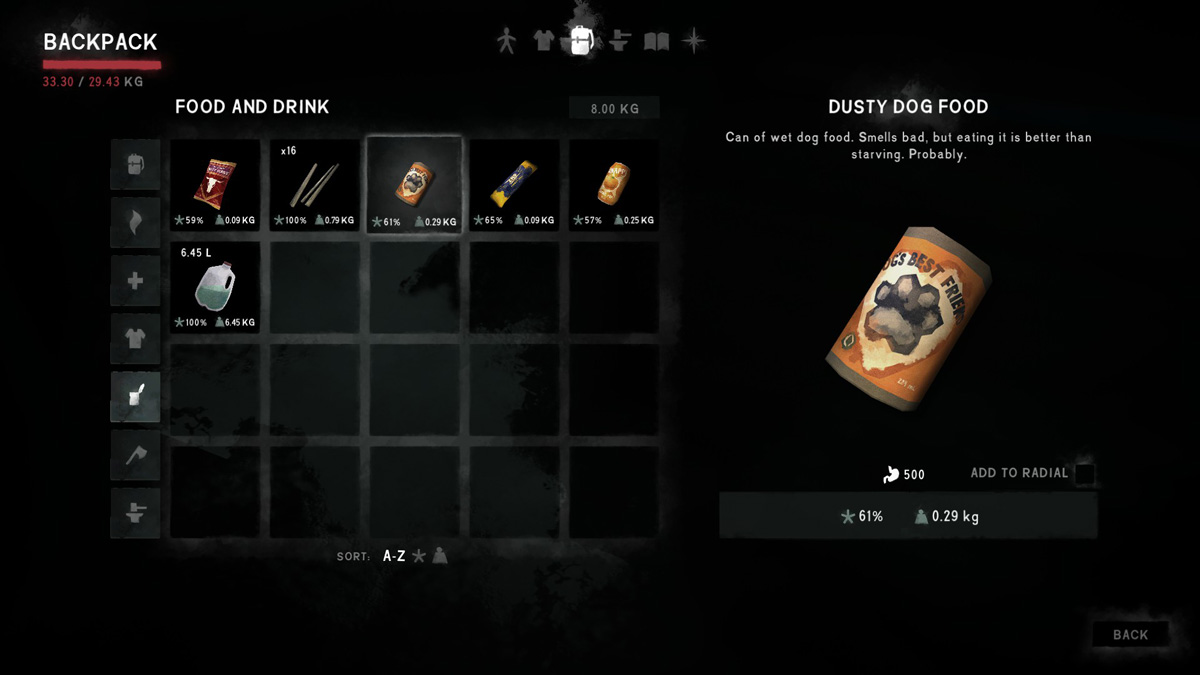
Food
The ever present hunger, gnawing at your stomach. Can you find enough food to survive? Even live a happy well fed life? Maybe...
Keep your meat, cooked and uncooked, outside in the snow. Meat will lose condition slower at lower temperatures so drop it outside to avoid it going bad while you are passing hours inside asleep or cooking by your campfire.
Cattail Stalks
Cattail stalks are worth their weight in gold. They are quick to harvest, never go bad, and are very lightweight. They are the only item In the game I hoard, and I hoard every cattail stalk I can pick—only using them as a last resort. I store excess Cattail Stalks at various bases and always carry twenty or thirty as an emergency food source.
Harvesting Animals
Build a fire while you are harvesting animals and cook your meat in small chunks. You can be harvesting Rabbits or a Deer carcass while simultaneously cooking each piece as it becomes available. Your fire will keep you warm as you should always be cooking outside to minimize your chance of getting Cabin Fever.
Note that on Stalker and Interloper difficulties eating Black Bear Meat or Wolf Meat has a chance of giving you Intestinal Parasites and/or Food Poisoning (unless you have your cooking skill maxed out at level five). Because of this it is best to avoid eating meat from carnivores until you are an expert chef.
Deer Carcasses
Finding a frozen Deer carcass early can make or break an Interloper run. If you don't have a tool that can harvest frozen carcases, such as a Hatchet or Hacksaw, building a fire next to the carcass will slowly thaw it, eventually allowing you to harvest it without any tools. I'm embarrassed how long it took me before I thought to try this, and how obvious it was afterwards.
Rabbits
You can hunt Rabbits. They don't produce much food but they do provide Fresh Rabbit Pelts and Fresh Guts which can be cured and crafted into survival gear such as clothing, Snares, and Fishing Line. Getting a few Rabbits curing early in your Interloper runs will pay off huge a few days later. Creating and setting Snares is a great proactive way to gather food.
Fishing
Fishing is an efficient way to quickly acquire a large amount of food. The drawback is you don't get any extra materials, such as pelts or guts. When you find a fishing hut make a mental note of its location so you can return when the time is right. You'll need a fishing Line and Hook—or you can cure a piece Fresh Gut and find a piece of Scrap Metal to craft into a Line and Hook. You'll also need something that can break the ice such as a Crowbar or Hatchet.
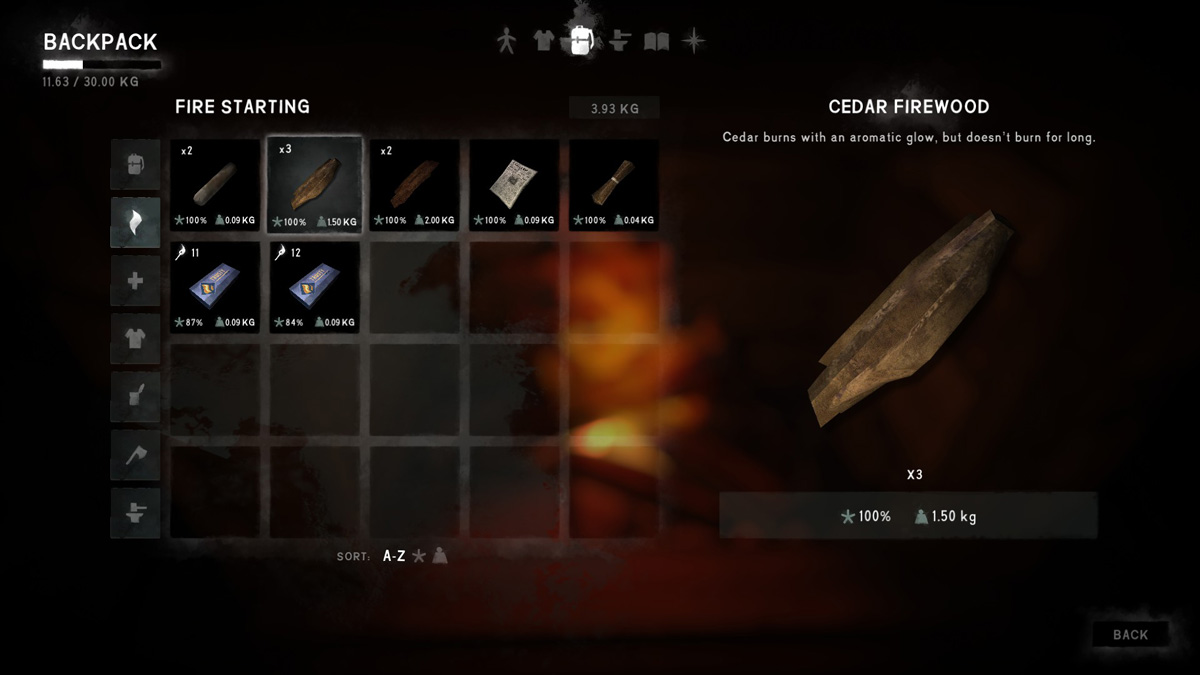
Firewood
You can't have too much firewood stockpiled. On Interloper if you see a Stick pick it up (unless, of course, you are being staked by a Wolf). I typically pick up every Stick I can find, even when encumbered—then pile them up for later. Sticks are one of the few completely renewable resources. Firelogs and things you can break down for fuel are limited and don't respawn. Sticks however respawn after every storm making them the perfect fuel for fires for those in it for the long-haul. Like Sticks, Coal is another renewable fuel resource. Coal can be found in caves and respawns periodically.

Fire Starting
Fire is life in The Long Dark. If you can't make fire you won't be able to purify water so you'll die pretty quick. I've had many Interloper runs end after fifteen minutes for just this reason. Your first priority should always be fire. Don't let anything stop you from moving quickly from spot to spot until you find some matches, a Flare, or other fire source.
Only build a fire when you absolutely need to. Make as much water and cook as much food as you can with each fire. If you can't carry it all stash it for when you return. Before making a fire make sure you have enough firewood to cook everything you plan to.
Matches
Maximize how much you can get out of each and every match when playing on Interloper. Especially early in the game.
When using matches to start a fire, always light a Torch first then light a fire with the Torch. Lighting a Torch is guaranteed to work—while lighting a fire can fail which results in a wasted match. By lighting a Torch first you can use the torch multiple times to attempt starting a fire, maximizing each and every single match.
Magnifying Lens
The Magnifying Lens is a real game changer. If you have it try to save your matches by always cooking outside during sunlight. This might not be possible depending on weather. Try to stretch your food and water supply between clear days and stock up on water and cooked meat anytime you can make a fire with the Magnifying Lens.
Firestriker
Like the Magnifying Lens the Firestriker changes everything. If you find one of these on Interloper lucky you, the game just got a whole lot easier.
I suggest you completely use up your Firestriker before using your matches. This will increase your Fire Starting ability so when you do use matches you have a higher chance of success.
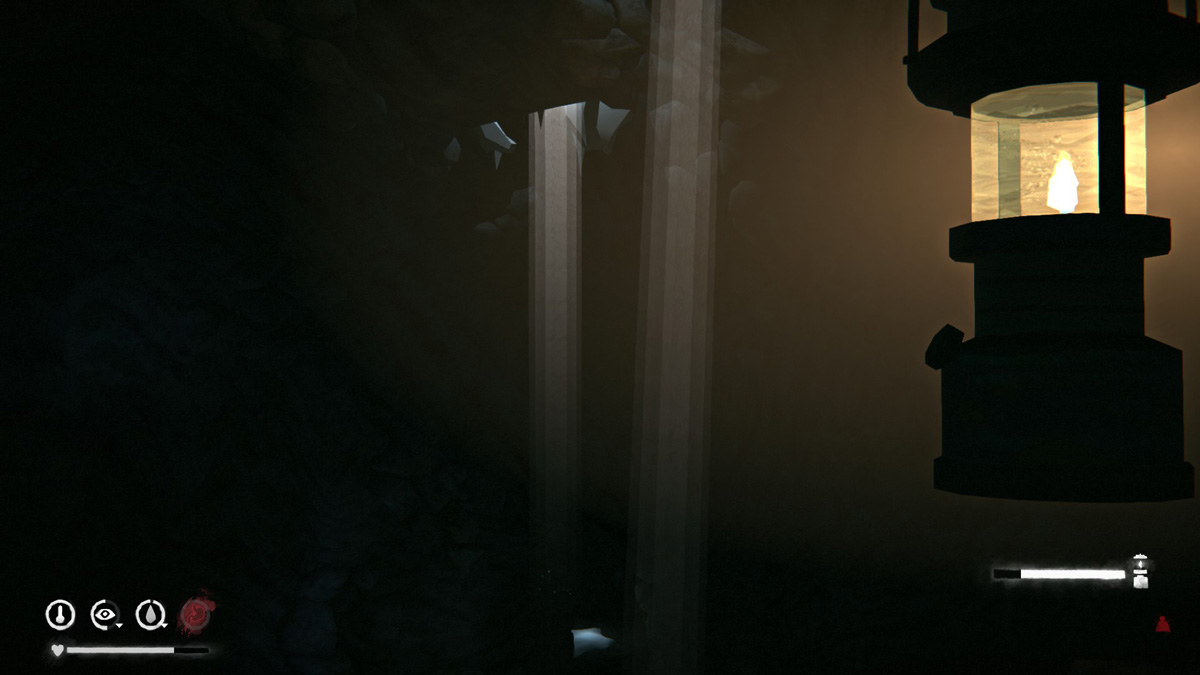
Finding Gear & Resources
Locating gear and resources on Interloper can be a serious challenge, especially early in the game. Knowing your way around is key for hitting high-loot spots early in the game.
Searching drawers, cabinets, and containers can yield some useful items, but the vast majority of these will be empty on Interloper. Your best bet is looking for gear and items that are sitting out on tables and shelves, tucked under crates and chairs, and wedged behind or beneath furniture such as beds, stoves, and cabinets.
Use a light source when searching whenever possible. May small items such as Candy Bars and Wood Matches will be all but invisible in low light. The Storm Lantern works best for searching but Torches work great too. You'll be amazed how much more you'll find when searching with an artificial light source.
When playing on Interloper you will not find Knives, Hatchets, or guns. Plan accordingly and collect as much Coal and Scrap Metal as you can early in the game. Try to get to a forge in the first few weeks with plenty of Coal and Scrap Metal. Aim to forge two Knives, two Hatchets, and one to two dozen Arrow Heads. If you can't make all this at once, make what you can, anything will help. The sooner you can cure Maple Saplings and Birch Saplings, craft a Knife, Arrow Heads, and finally craft a Bow and Arrows in your Interloper run, the sooner you can start hunting Moose and Bear for their pelts. The Moose-hide Satchel, Bearskin Coat, and Bear Skin Bedroll will be extremely helpful for carrying all your necessary gear and keeping you protected from the cold.
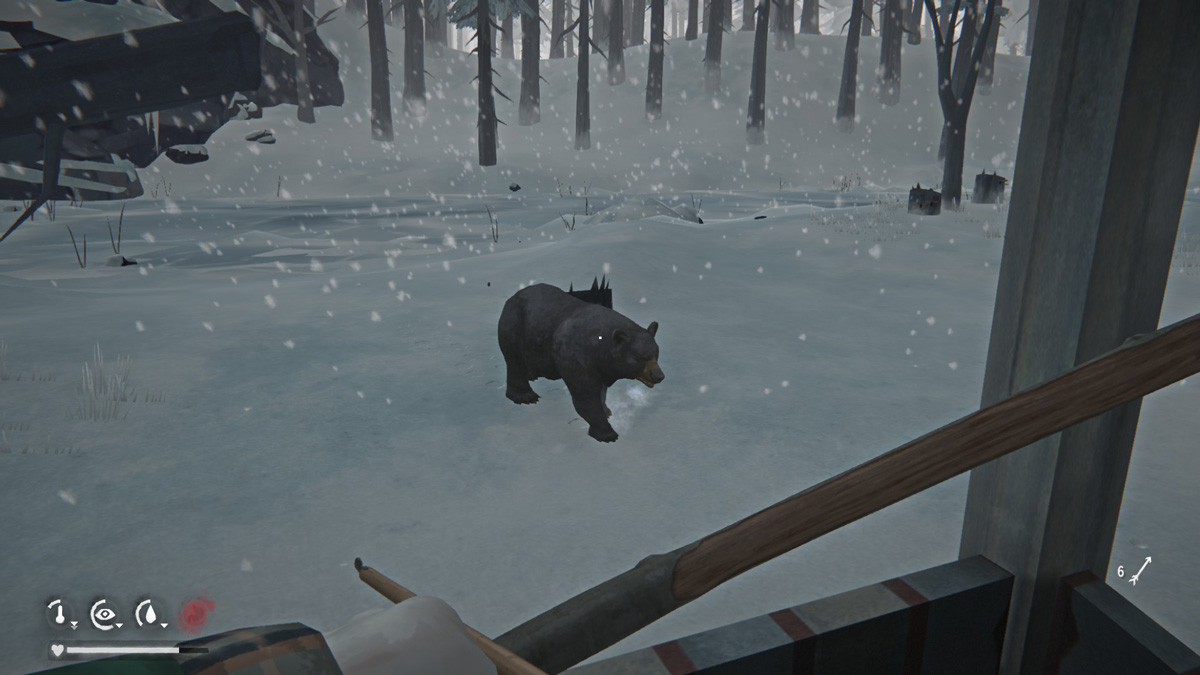
Hunting
Rabbits
You can throw rocks at Rabbits to stun them, then rush to pick them up and snap their necks. It's a brutal fate for these cute little animals but survival is not for the lighthearted. This technique might seems obvious to some people, but I didn't even think this was possible on my first few playthroughs. (Reality check: this is not a practical way to survive in the wild, always keep in mind, this is just a video game.)
Rabbits are also the only possibility of a passive food source in the game. Once you can craft a Snare or two set them up in an area frequented by Rabbits. Check your Snares once a day and you'll have excess Rabbit meat and Cured Rabbit Pelts in no time.
Deer
Hunting Deer is the most straightforward animal to hunt in The Long Dark. After shooting one with an Arrow or Bullet, follow its trail of blood until it bleeds out then build a fire and get to harvesting.
Moose
Moose are much more rare to find than Deer or Bears and don't stay in the same location for long. Their hide is extremely valuable as it can be used to craft a Moose-hide Satchel which grants you an extra five kilogram carrying capacity. A headshot to a Moose with the Bow or a gun can sometimes take it down instantly. If you miss the Moose will likely charge and you could be nursing broken ribs for days. Just like the Deer, if you hit a Moose but don't kill it, follow its trail of blood until you find it. Don't wait to track it later as the trail of blood can quickly get covered up by falling snow.
Bears
Best method for hunting Bear is to wait patiently in a Hunters Blind in an area where you have spotted a roaming Bear. The blind will keep you safe from a Bear attack. Alternatively hunting a Bear from high ground or simply crouching (which reduces the amount of noise you make) and sneaking up on it unaware can work if you are willing to risk it. Where you hit a Bear with your Bow or gun is essential since only a perfect headshot to a Bear's eyes will be fatal. Be ready to drop Bait before the Bear charges you then fire off as many shots as you can while it is distracted. Shoot for a critical hit by targeting the head, neck, and chest. If you are lucky and the Bear runs away after being hit, track it down and hope it bleeds out.
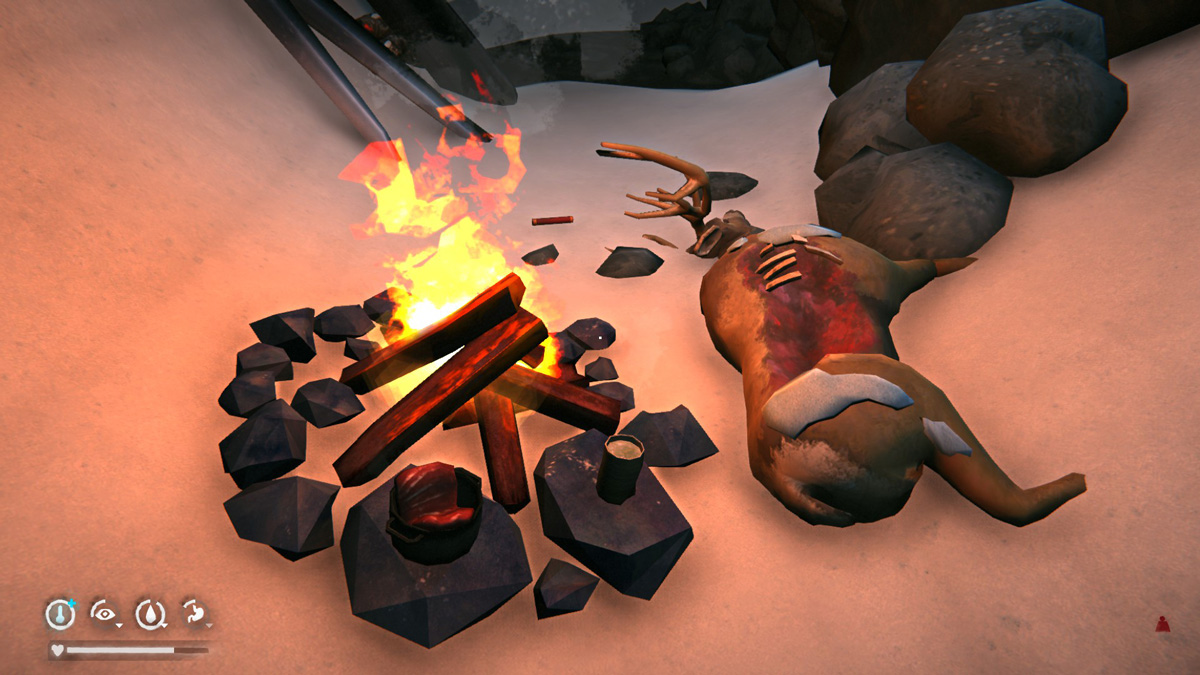
Cooking
Slice your meat into as small of chunks as possible. This takes more time to harvest and cook, but has a few subtle benefits. It maximizes the number of times you cook which will increase your Cooking skill. Additionally it makes it easier to eat smaller portions which can be helpful when using starvation techniques.
Cooking raises the condition of food, so cook up that rusty can of Tomato Soup (or rotting Venisons, or whatever) before eating it. This will help decrease your changes of getting Food Poisoning from eating rancid food.
Coffee
When you find a Tin of Coffee (or box of Herbal Tea) cook it all the next chance you get. Coffee will boost your energy when drank cold so it's best to have it ready to drink before you are freezing and dying of exhaustion. Cooking as many drinks as you can will increase your Cooking skill.
Herbal Tea & Birch Bark Tea
Herbal Tea and Birch Bark Tea are two of the most precious items in the game. When drank hot these items grant the Improved Rest bonus which drastically increases how much health you regain while asleep.
I try to save these items until I'm on death's door—then making sure I'm hydrated and tired enough to sleep for ten hours straight—heat it, drink it, sleep, and regain as much health as possible.
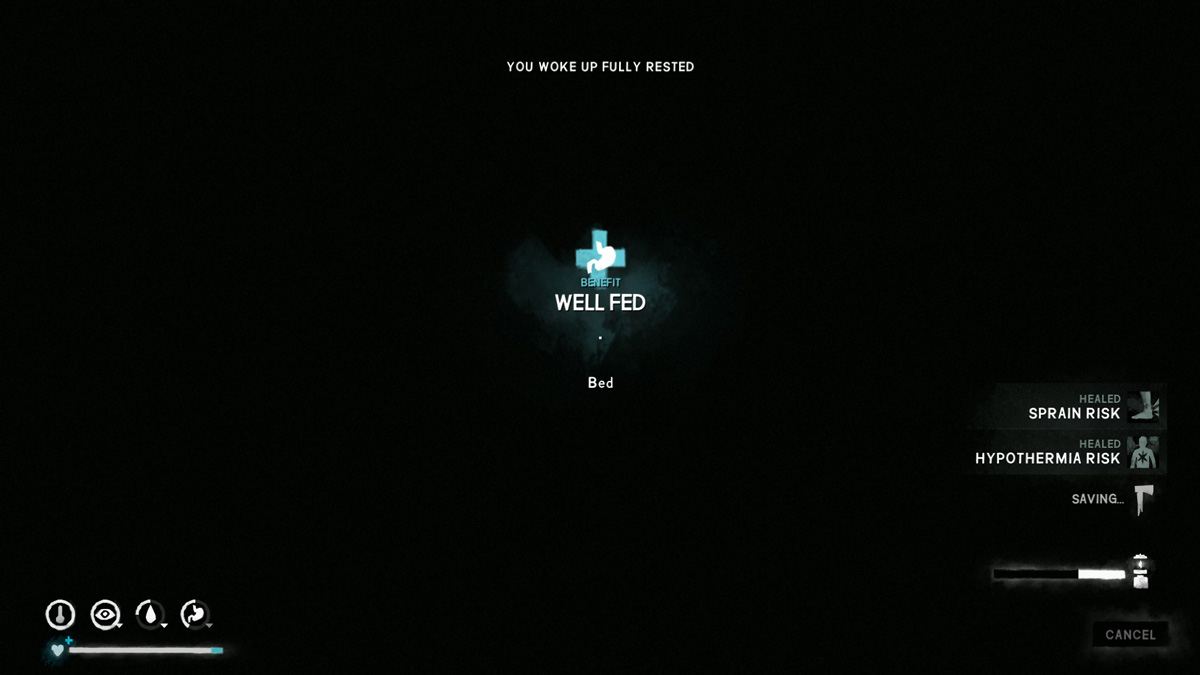
Starvation Techniques vs. The Well Fed Bonus
Hunger is the attribute that will affect your condition the least when depleted. Additionally you burn less calories when you sleep. So it's not that bad to run around all day hungry. Consequently you can starve yourself during the day then gorge yourself on your food stores right before going to sleep. This will maximize your food. Preforming strenuous tasks like running and harvesting when starving doesn't waste calories or food. I call this the starvation technique, and seems like this play style is pretty much required to survive on Interloper, at least at the beginning of the game.
Avoid using the starvation technique when your condition is low, such as below twenty five percent. Keeping some food in your belly will help conserve your condition and you can even slowly regenerate condition during the day if none of your stats are depleted and you have no negative afflictions.
On the other hand, if you can constantly keep at least a few calories in your belly at all times you'll receive the Well Fed bonus after three days, giving you a boost to your maximum condition and increasing your carrying capacity by five kilograms. If this bonus can be maintained it can give you a significant edge to surviving.
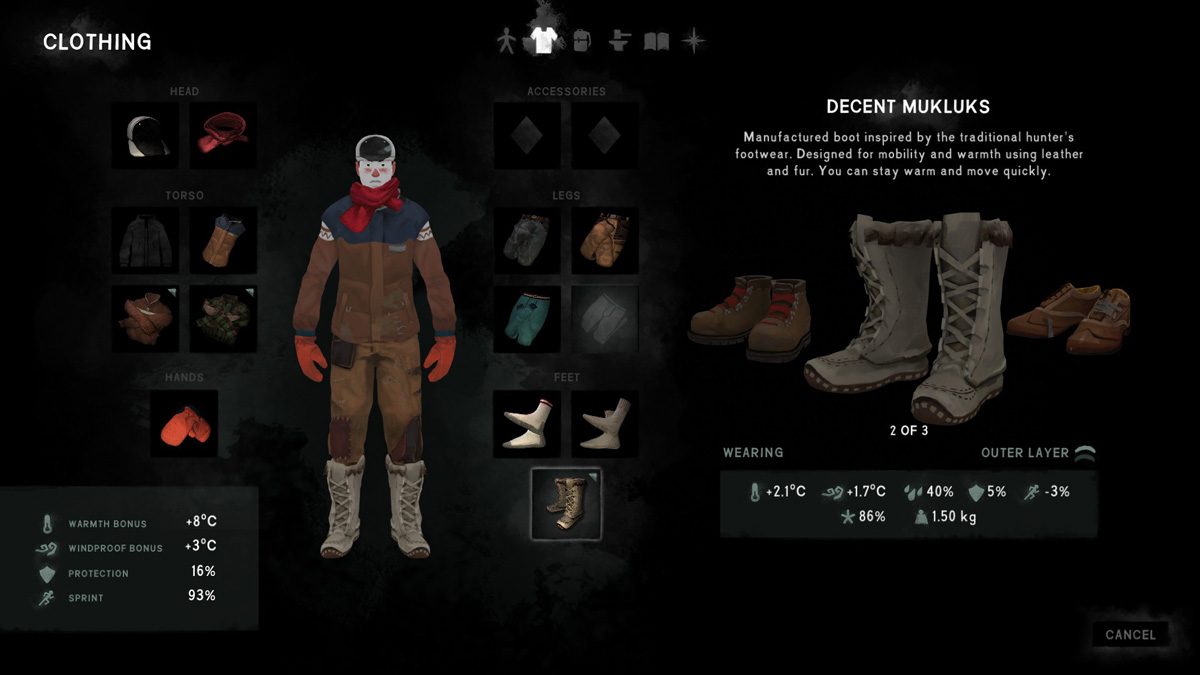
Clothing
Warm clothing is essential for survival in The Long Dark. Layering it up can help keep the wet and cold in check but keep in mind how much weight it will add. Extra clothing weight means you will move slower and can carry less other essential gear. Consider the warmth-to-weight ratio of each article of clothing. The Mariner's Pea Coat, for example, provides a nice 3° warmth bonus and weighs 2kg. The Ski Jacket on the other hand, while only providing a 2° warmth bonus, only weighs 1kg. So the Ski Jacket has a better warmth-to-weight ratio. This subtlety applies to all articles of clothing so choose what you wear wisely. If you are sprinting between locations and know you can make the trip with only one layer of clothing, ditch those extra jackets, shirts, hats, pants, and socks and pick them back up later. If you need to spend extended time outside in the cold remember to layer up.
Similarly the shoes you choose to sport make a big difference. Combat Boots give you a small warmth and protection boost at the cost of a 7% mobility penalty. The Running Shoes however have almost the same warmth bonus and will keep you sprinting as long as possible.
Protection is another important factor to keep in mind when choosing your outfit. Heavier clothing will typically slow you down and fill up your carrying capacity, but if you get in a scuff with a wolf every bit of protection will boost your chance of survival.

Rest
Regaining condition when resting is cumulative. Meaning the longer you rest the more condition you gain for each hour asleep. Note that all your stats must be positive to gain condition. If you are starving, dehydrated, or freezing you will instead lose condition while sleeping. Additionally some afflictions, such as Food Poisoning or Dysentery, prevent condition recovery completely including while asleep.
On Interloper your hydration meter drops faster than other difficulties making ten hours the optimal length to sleep. Once you hit the eleventh hour of rest you will actually start losing condition due to dehydration.
Being exhausted at the end of the day is the key to a full night's sleep. And a full night's sleep is the only chance you have to regain all the condition you lost during the day due to cold and starvation. Running everywhere will help drain your energy bar so when night falls you can settle in for a nice long nap. Try to time depleting your energy bar with the sun setting and getting to a safe warm location, since there are not many productive activities you can do in the dark. The last thing you want is to be fully rested with nothing to do but sit and wait wide awake in total darkness.
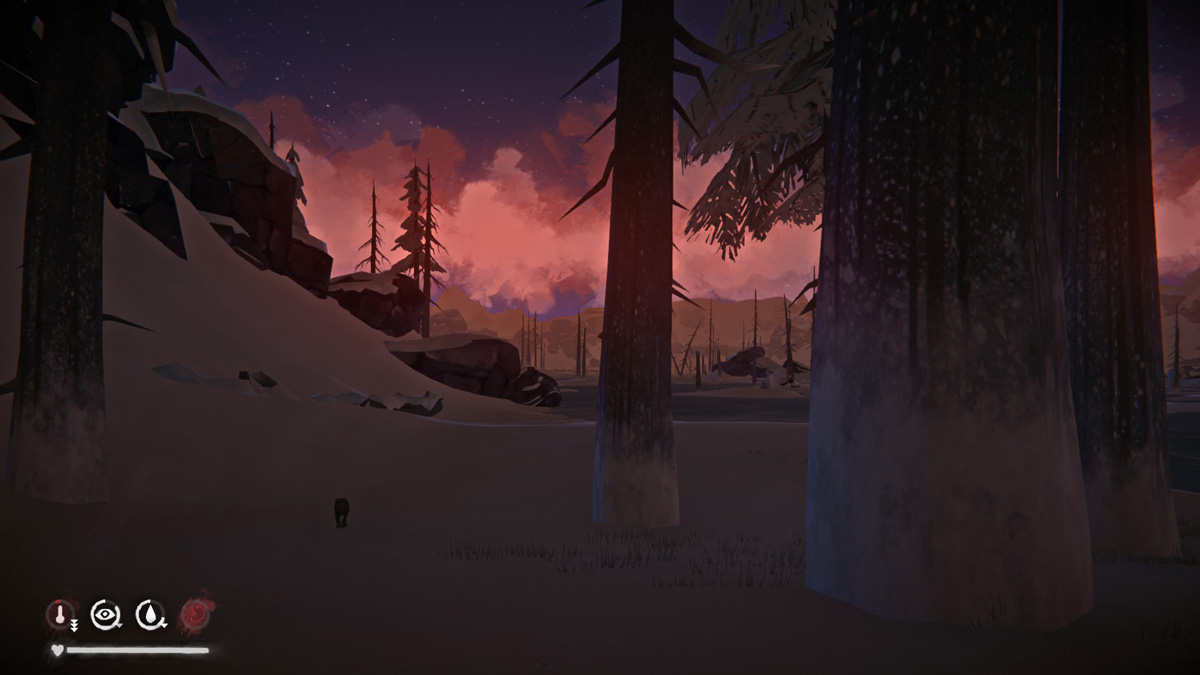
Dealing With Wolves
Wolves are without question the most difficult and unforgiving part of The Long Dark. Realistically you won't die from the cold and you won't die from starvation—a surprise Wolf is the most likely thing that will get you in the end. Here are a few tips, in order of actions you should take, to help you manage Wolf attacks. They are by no means foolproof.
Evading Wolves
Being stalked by a Wolf? These tips will help.
- If you hear a Wolf bark (not to be confused with Wolves howling in the distance) immediately try to figure out which direction the Wolf is in.
- When you see a Wolf immediately start walking in the opposite direction. Don't run! Running often aggravates Wolves making them charge at you. Move in the direction of the nearest building and enter it if possible. Sometimes you can sprint to get away from them if you can get to a door, or otherwise cross a log or similar, that the Wolf can't move into or past.
- Sometimes Wolves will strife sideways so frequently maintain eye contact while constantly moving away from them.
- If you can't get to shelter, try to move over rocks or around walls or fences where the Wolf can't follow you. Sometimes it is possible to lose the Wolf in the terrain. Wolves won't move down cliffs, but you can if you are extremely careful. This can often be the easiest way to lose a Wolf.
- If there is a Rabbit or Deer nearby you can sometimes lure the Wolf into attacking them instead of you. Allowing you make a clean getaway while the Wolf is feasting.
- If you have a Flare Gun (always keep it loaded) shoot a flare directly at the Wolf. This is the most foolproof way to get a Wolf to run away but it's not a 100% guarantee.
- As a last resort you can quickly light a Torch then build a fire. Place the fire directly between you and the Wolf. This will usually scare a Wolf away when he moves too close to the fire.
Avoiding Wolves
Avoiding Wolves completely at all costs is guaranteed to be your best strategy.
- Frequently look in all directions when traveling, scanning for Wolves in the distance. If you spot one navigate around it keeping your distance.
- Beware of fog. Traveling in the fog is the most dangerous weather to be surprised by a Wolf due to the extremely limited visibility.
- Stay upwind of any Wolves you see in the distance. If you are downwind from a Wolf the wind will carry your scent to them, luring them to you, especially if you are packing any raw meat or uncured guts or pelts.
- Avoid traveling when the Aurora is out. Wolves are much more aggressive during the Aurora.
- Wolves usually don't come out in blizzards. If you can stand the cold and know how to stay oriented, traveling during blizzards is actually a good way to not get in a tangle with a fanged doggo.
- Stay on high ground. Wolves typically stick to the lowest elevation such as frozen rivers, lakes, and coastlines as well as trails and passes. Hiking ridgelines instead of low paths will help keep you above and away from wolves.
Fighting Wolves
If you end up in a fight with a Wolf chances are it won't end well, however there are things you can do to be more prepared for these unfortunate and inevitable events.
- The more protection your clothing gives you the better chance you'll have of making it out of a Wolf tangle in one piece.
- Fighting a Wolf will almost always result in the loss of condition. So the higher your condition when getting attacked by a Wolf, the higher your chances of survival. Similarly the more rested you are the more damage you will do. Getting attacked by a Wolf when fatigued is a recipe for a game over.
- Carrying a Knife, Crowbar, or Hammer will help you fight back against a Wolf. Alternatively carrying a piece of Scrap Metal will help if that is all you have. Using the Knife is less likely than the Hammer or Crowbar to scare a Wolf away quickly, but it will usually cause the Wolf to bleed out, allowing you to track its blood trail or find its carcass for harvesting later. If you want to scare the Wolf away as fast as possible, saving you the most condition, use the Hammer.
- Always carry two or three Bandages, Painkillers or a few cups of cooked Rose Hip Tea, and Antiseptic or a few Old Man's Beard Wound Dressings. If you do survive a Wolf attack addressing your afflictions as soon as possible will help prevent dying from the wounds shortly after.
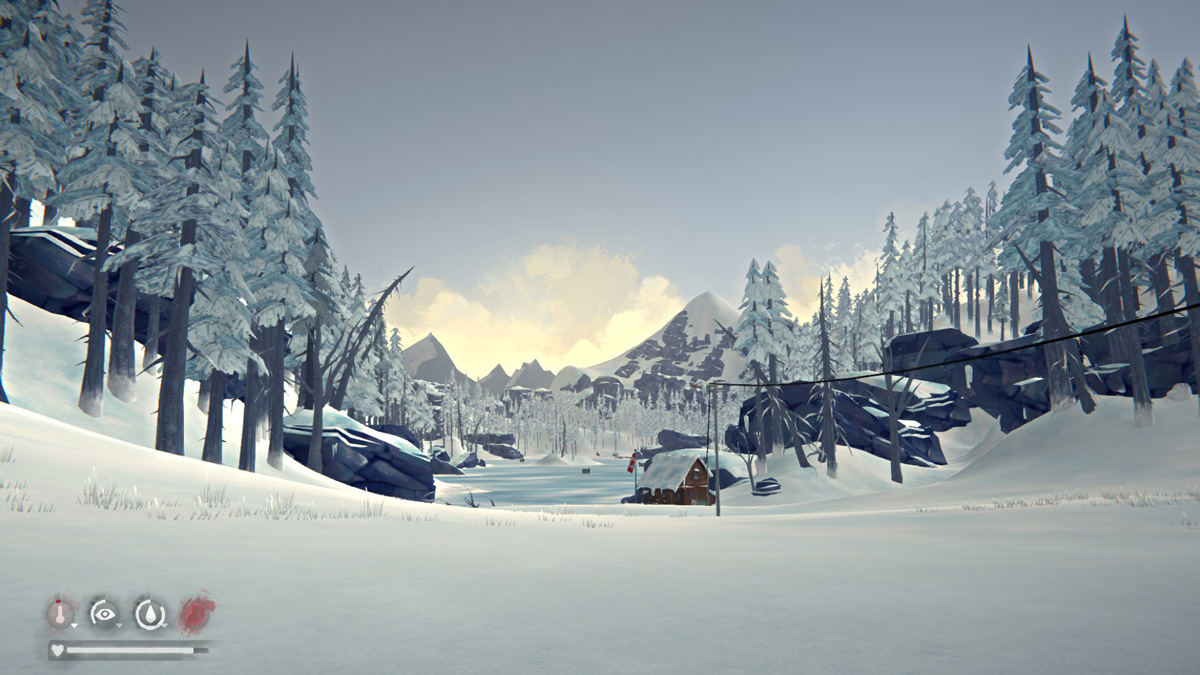
Avoiding Cabin Fever
Cabin Fever sucks and you should try to avoid it at all costs. Proactively maximizing your time outside and being prepared for sleeping outside will help you avoid getting the Cabin Fever affliction. Luckily there are several techniques and activities you can do to help avoid Cabin Fever.
- Eat, drink, and craft outside when possible. The outdoor furnace in the Forlorn Muskeg and the outdoor workbench at the Coastal Highway are a few locations to craft outside.
- Try to always cook outside. This might not always be possible due to weather, so try capitalize on decent weather by cooking outside when you can. This is a great outdoor habit to get into for avoiding Cabin Fever because your campfire will keep you warm while cooking.
- Build a Snow Shelter before it is too late, especially if you haven't found a Bedroll yet. The last thing you want to happen is to get Cabin Fever Risk when you don't have sufficient resources (of Sticks and Cloth) to build a Snow Shelter. Think ahead and be prepared to sleep outside before it is to late.
- If you do have a Bedroll, sleeping in a cave is a great way mitigate Cabin Fever Risk. The back of caves stay fairly warm and are typically sufficient for sleeping through the night without a fire. Take note of cave locations as you explore each zone.
- If you have to kill time waiting (which you should try to avoid), wait outside as long as you can. Watch your temperature meter and cancel waiting and duck back inside right before receiving Hypothermia Risk.
Hope you liked my run-down of how to survive The Long Dark. If I missed any key strategies note them for others in the comments.
Comments
1. Be really careful about wolves when descending ropes. They often lurk near the bottom, just when you lack condition to climb back up again.
2. Use 'sneak' (CTRL key) when wolves and bears are near, and when topping ridges if you've heard wolves howling. It makes a huge difference. Sneak plus hiding behind a rock can allow you to avoid wolves that are really close.
3. Use your ears. Wolves, bears, moose, crows and even deer can often be heard before they are seen.
4. Keep an eye on nightfall. It can come quickly and leave you stranded. Finding your way in pitched darkness is really tough, and if its the aurora wolves go mad. Plan where your next sleeping spot is.
5. Keep accelerant, lamp oil and books for quickly lighting fires in a survival emergency, eg wolf attack.
6. Get familiar with the properties of different clothing, food and fuel. With fuel, some burns slowly with little heat, some quickly with great heat. This knowledge can save you from freezing to death. Knowing weight to warmth and weight to calorie ratio is important in avoiding encumbrance.